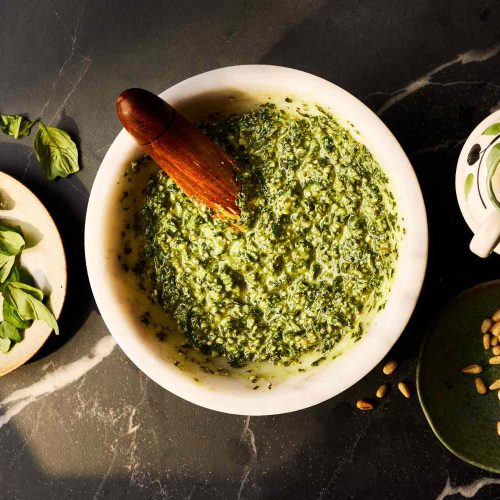
Pesto Genovese
Pesto Genovese is a classic Italian sauce hailing from the Liguria region, particularly the city of Genoa, which is its namesake. At its core, Pesto Genovese is a vibrant green, uncooked sauce known for its simple yet robust flavors. The traditional recipe calls for fresh basil leaves, which are the star ingredient, providing an aromatic freshness that is unmistakable. These are combined with pine nuts, which add a subtle nuttiness and creamy texture, and garlic, which contributes a pungent kick that enlivens the palate.Parmigiano-Reggiano and Pecorino cheese bring a savory depth and a touch of saltiness to the sauce, while extra-virgin olive oil binds all the ingredients together into a smooth, rich emulsion. The method of preparation is also key; historically, the ingredients are ground together using a mortar and pestle, which is said to release the flavors in a way that mechanical processing cannot match.Pesto Genovese is versatile and can be used in a variety of dishes, most commonly as a pasta sauce, where it clings to the noodles, imparting its bold, herbaceous flavor with every bite. It's also used as a condiment or a spread, adding a burst of flavor to sandwiches, pizzas, and more. The sauce is not only cherished for its taste but also for its association with the Mediterranean diet, being made from fresh, wholesome ingredients that are emblematic of the region's cuisine.In summary, Pesto Genovese is a celebration of Italian culinary tradition, encapsulating the essence of its ingredients in a sauce that is both simple in its composition and complex in its flavor profile. It stands as a testament to the beauty of Italian cooking, where quality ingredients and time-honored methods come together to create something truly special.
Equipment
- 1 special boxwood hammer
Ingredients
- 50 grams of fresh basil
- ½ cup of cold pressed olive oil
- 2 cloves garlic
- 8 tbsp. grated parmesan cheese
- 2 tbsp Pine nuts
Instructions
- A few grains of coarse sea salt Crush the garlic and salt in a mortar. Add the pre-washed and dried basil leaves little by little. The basil leaves are also crushed with careful, swirling movements. When the leaves release their fragrant oils, it’s time to add the pine nuts. Once the ingredients are well crushed in the mortar, add the grated Parmesan cheese and a thin stream of olive oil. Cooking is done at room temperature, and consumption is best done immediately to avoid oxidation and darkening of the sauce. If it accidentally remains or we make a larger dose, we can store it in a tightly closed jar in the refrigerator, but not more than 2 days.
- The other option is freezing. The recipe is different in each family or restaurant, but it is these small differences that make the tasting of the sauce a real thrill. Tradition dictates that pesto be prepared in a marble mortar and without access to any metal tools. The ingredients are crushed in the mortar with a special boxwood hammer. From the word pestello (hammer), by the way, comes the name of the sauce.
- Although there is no heat treatment in its preparation, the pesto requires a solid dose of patience. Especially in cases where the traditional way of cooking by hand is followed. Naturally, it was not lacking for the Italian hosts from the Liguria region, who, while waiting for their husbands to return after a long voyage, had enough time to indulge in labor-intensive culinary magic. A little out of tradition are all the other variations of the pesto. And they are really many: pesto of dried tomatoes, with different types of nuts, with capers and anchovies, with arugula.